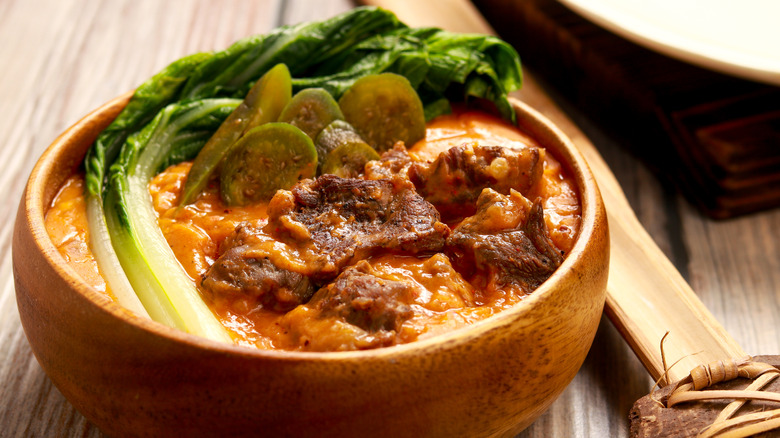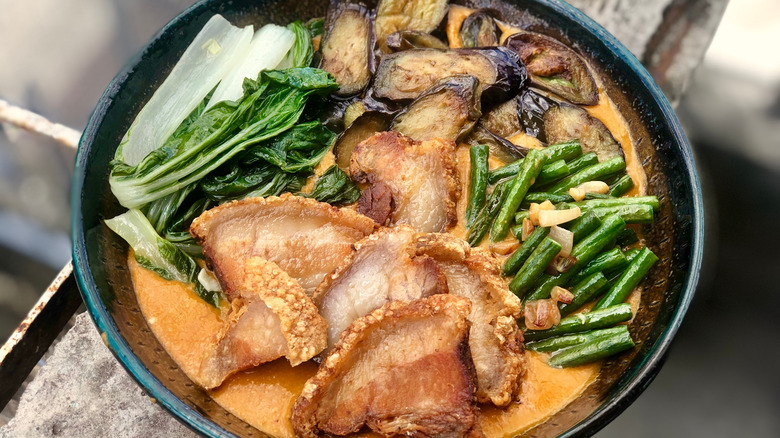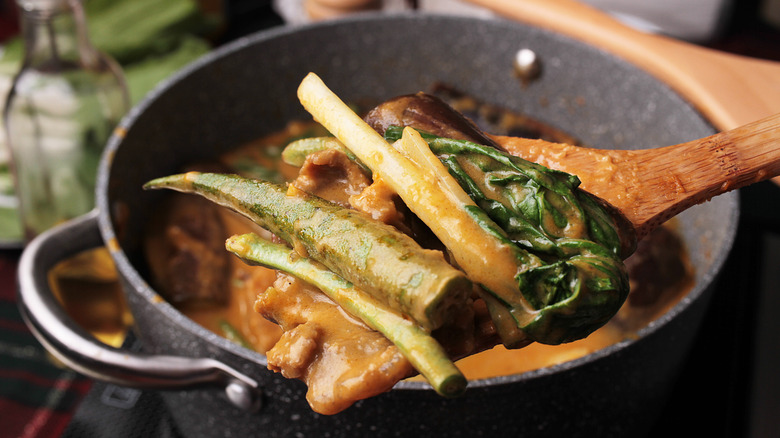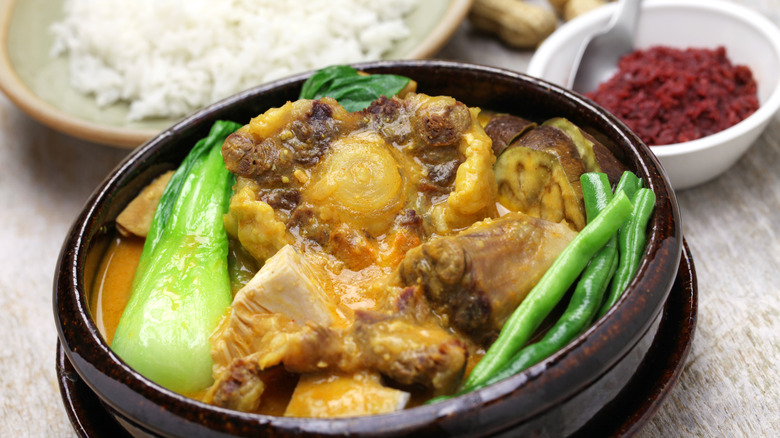Kare Kare: The Comforting Filipino Peanut Stew
Anywhere you go in the Philippines, you're sure to find kare kare or Filipino curry. As you might assume, the name of the dish comes from the word "curry." According to Culture Trip, kare kare essentially translates to faux curry because although it resembles the Indian sauce in appearance, the actual flavor and components are very different.
However, the origins of kare kare and its relationship to curry are a subject of dispute, Foodicles explains. One historical narrative suggests that kare kare was created by the Sepoys — the Indian soldiers sent by the British from 1762 to 1764. The story is that they couldn't make curry the traditional way and had to substitute the spices for Filipino ingredients, thus creating kare kare.
According to Esquire, the Kapampangans, native to the province of Pampanga, argue they were the ones who originally invented it but admitted to naming it kari after the word for sauce in the Indian language of Tamil. The Tagalogs of the Pasig River take credit for its invention, too, claiming it was a better version of Kapampangan's kari, hence the name kari kari, which eventually evolved into its current name, kare kare. Whether you believe Indians or Filipinos invented it, there's no denying it's a delicious dish.
What is kare kare made of?
Though kare kare's history is a subject of debate, the ingredients included in it are generally agreed upon. Per Rassa, the base of the stew always gets its flavor from peanuts. Traditionally roasted peanuts are ground into a paste, but nowadays, people more often use peanut butter. To enhance the creaminess and viscosity, ground rice is also added. According to Taste Atlas, tenderized beef, usually oxtail or shank, is the main protein, and it's sometimes joined by tripe and intestines but can easily be replaced with pork leg, goat, or chicken. Cooked alongside the meat is a medley of vegetables, primarily eggplant, string beans, banana blossoms, and pak choi.
To give kare kare its signature reddish hue, achiote seeds are toasted in oil to release a natural food coloring called annatto. Aside from the achiote seeds, kare kare traditionally doesn't include other spices, Taste Atlas points out, though chilies are often added for extra heat.
Kare kare sa gata is creamier with coconut milk
Kare kare is a creamy stew, thanks to the use of peanut butter and ground rice, but there's another version that's even creamier — kare kare sa gata. According to Panlasang Pinoy, this version of kare kare is made exactly the same way but with the addition of gata, which means coconut milk in Tagalog. Per Today's Delight, kare kare sa gata uses coconut milk from fresh matured coconut meat rather than canned coconut milk. This results in a kare kare that is extra rich and slightly sweet.
Kare kare sa gata likely developed due to the regional availability of coconut. As Yummy explains, in Southern Luzon, coconut milk is a popular addition in many recipes like adobo, and kare kare is no different. In the region of Bicol, both coconut and seafood are abundant (via Taste Atlas), so kare kare made with coconut and seafood is also common, per Yummy.
Kare kare is cooked and served in a clay pot
You can easily make kare kare in a large pot or a dutch oven, but a palayok is the traditional cooking medium, Taste Atlas says. A palayok, according to Panlasang Pinoy, is a large pot made out of clay used to both cook and serve certain Filipino dishes. When cooking kare kare in a palayok, it's placed over hot coals instead of a regular stove. Serious Eats explains that the process of cooking the dish starts with searing the oxtail or fatty meat in garlic, onion, and scallions, then adding water and reducing to a simmer. Peanut butter, ground rice, or toasted rice powder is added to the broth to build the saucy base, followed by the achiote seeds or annatto powder, as well as the vegetables.
Kare kare can be served directly in the palayok or in a bowl with rice and a condiment called bagoong (via Rassa). Bagoong is made of sauteed fermented fish paste and adds the perfect touch of saltiness to the rest of the ingredients.



